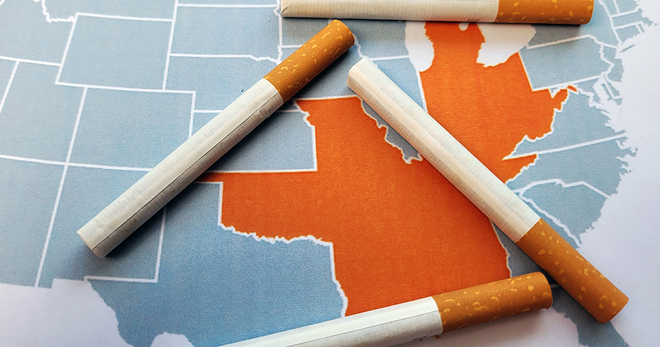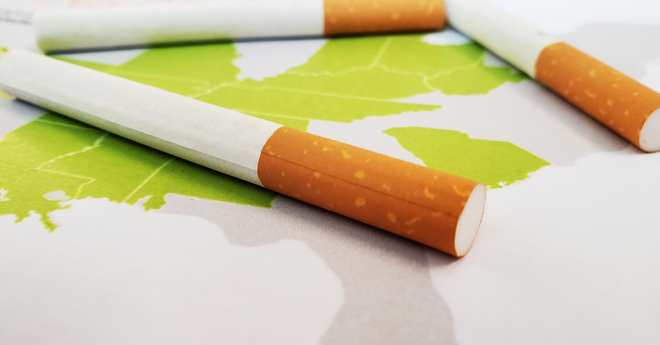Tobacco use in Illinois 2019
Cigarette use: Illinois*
Cigarette use in Illinois
- In 2017, 15.5% of adults smoked. Nationally, the rate was 17.1%.1
- In 2017, 7.6% of high school students in Illinois smoked cigarettes on at least one day in the past 30 days. Nationally, the rate was 8.8%.2
Other tobacco product use: Illinois
E-cigarette and smokeless tobacco use in Illinois
- In 2017, 4.4% of adults used e-cigarettes and 2.6% used smokeless tobacco.3
- In 2017, 13.2% of high school students in Illinois used electronic vapor products on at least one day in the past 30 days. Nationally, the rate was 13.2%.2
- In 2017, 5.6% of high school students in Illinois used chewing tobacco, snuff or dip on at least one day in the past 30 days. Nationally, the rate was 5.5%.2
- In 2017, 8.1% of high school students in Illinois smoked cigars, cigarillos or little cigars on at least one day in the past 30 days. Nationally, the rate was 8.0%.2
Economics of tobacco use and tobacco control
Economics of tobacco use in Illinois
- Illinois received $1.0688 billion (estimated) in revenue from tobacco settlement payments and taxes in fiscal year 2019.4
- Of this, the state allocated $9.1 million in state funds to tobacco prevention in fiscal year 2019, 6.7% of the Centers for Disease Control and Prevention’s annual spending target.4
- Smoking-related health care costs: $5.49 billion per year4
- Smoking-related losses in productivity: $5.27 billion per year5
Illinois tobacco laws
Cigarette tax in Illinois
Tobacco taxes
- Illinois is ranked 10th in the U.S. for its cigarette tax of $2.98 per pack (enacted June 2012), compared with the national average of $1.81. (The District of Columbia has the highest tax at $4.50 and Missouri has the lowest at 17 cents.) 6-8
- Little cigars are taxed at 9.9 cents per cigar. Moist snuff is taxed at 30 cents per ounce. All other tobacco products are taxed at 36% of the manufacturer’s list price.6,7
Clean indoor air ordinances
- Smoking is prohibited in all government workplaces, private workplaces, schools, childcare facilities, restaurants, bars, casinos/gaming establishments, retail stores and recreational/cultural facilities.6,7
- The use of e-cigarettes is prohibited on public higher education campuses and in any building or structure in the Illinois Capitol Complex.9
Youth access laws
- The minimum age to purchase tobacco products in Illinois is 21. In December 2019, the United States adopted a law raising the federal minimum age of sale of all tobacco products to 21, effective immediately.
- Establishments are required to post signs stating that sales to minors are prohibited.6,7
- Minors are prohibited from buying alternative nicotine products, including e-cigarettes.6,7
Local tobacco laws
- The city of Chicago:
- Prohibits the sale of flavored tobacco products or accessories, including menthol, within 500 feet of any city high school11
- Requires a retail tobacco license for the sale of e-cigarettes and bans the distribution and sale of e-cigarettes to minors, prohibits the sale of e-cigarettes within 100 feet of a school and/or day care facility, and requires e-cigarettes be stored in a manner that is not physically accessible to the public11
- Bans the use of smokeless tobacco at professional and amateur sporting events, including at Wrigley Field and Guaranteed Rate Field12
- Prohibits retailers from redeeming coupons or other discounts on tobacco products11
- Prohibits the sale of little cigars in packages of less than 1011
Quitting statistics and benefits
Quitting statistics in Illinois
- The CDC estimates 46.7% of daily adult smokers in Illinois quit smoking for one or more days in 2017.3
- In 2014, the Affordable Care Act required that Medicaid programs cover all quit medications.7**
- Illinois’s state quit line invests $2.11 per smoker, compared with the national average of $2.21.7
- Illinois requires that most private health insurance plans be in compliance with ACA guidance on quitting tobacco as a preventive service.7
Notes and references
Updated April 2019
*National and state-level prevalence numbers reflect the most recent data available. This may differ across state fact sheets.
**The seven recommended quitting medications are NRT gum, NRT patch, NRT nasal spray, NRT inhaler, NRT lozenge, Varenicline (Chantix) and Bupropion (Zyban).
Fiore MC, et al. Treating Tobacco Use and Dependence: 2008 Update. Clinical Practice Guideline. Rockville, MD: US Department of Health and Human Services. Public Health Service: May 2008.
1. CDC, Behavioral Risk Factor Surveillance System, 2017.
2. CDC, Youth Risk Behavior Surveillance System, 2017.
3. CDC, Behavioral Risk Factor Surveillance System, State Tobacco Activities Tracking and Evaluation System, 2017.
4. Campaign for Tobacco-Free Kids, Broken Promises to Our Children: a State-by-State Look at the 1998 State Tobacco Settlement 20 Years Later FY2019, 2018.
5. Campaign for Tobacco-Free Kids, Toll of Tobacco in the United States.
6. American Lung Association, State Legislated Actions on Tobacco Issues (SLATI).
7. American Lung Association, State of Tobacco Control, 2019.
8. Campaign for Tobacco-Free Kids. State Cigarette Excise Tax Rates & Rankings. https://www.tobaccofreekids.org/assets/factsheets/0097.pdf.
9. Public Health Law Center. U.S. E-Cigarette Regulation: 50-State Review. http://www.publichealthlawcenter.org/resources/us-e-cigarette-regulations-50-state-review.
10. Campaign for Tobacco-Free Kids. States and Localities that have Raised the Minimum Legal Sales Age for Tobacco Products to 21. https://www.tobaccofreekids.org/assets/content/what_we_do/state_local_issues/sales_21/states_localities_MLSA_21.pdf.
11. City of Chicago. Tobacco Regulations. 2016; https://www.cityofchicago.org/city/en/depts/bacp/supp_info/tobaccoregulations.html.
12. Knock Tobacco Out of the Park. https://tobaccofreebaseball.org/.
More in smoking by region
Want support quitting? Join EX Program
By clicking JOIN, you agree to the Terms, Text Message Terms and Privacy Policy.
Msg&Data rates may apply; msgs are automated.





